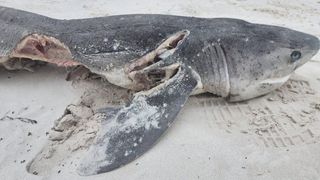An orca killing spree continues in South Africa. Their target: shark livers.
So, what is it about shark livers that seemingly whet the appetite of these blood-thirsty orcas?

Related: 5 gruesome killer whale attacks
In her tweet, Kock explained that “they likely initially learn by experience when first predating a new species,” meaning that once the orcas were aware of the liver’s location on a shark “they will remember it forever and become more efficient [hunters].”
It also helps that shark livers are “highly nutritious and have large quantities of fats and vitamins,” Kock told Live Science in an email. “Orcas may have learned that consuming shark livers provides high energy and nutrients. Sharks’ livers are large and buoyant, and they float to the surface of the water when a shark is killed. This makes them easy for orcas to spot and access, compared to other organs that may sink to the bottom or be harder to locate.”
 Port and Starboard, a pair of killer whales, on the hunt for fresh shark livers. (Image credit: Alison Kock)
Port and Starboard, a pair of killer whales, on the hunt for fresh shark livers. (Image credit: Alison Kock)
Similar to tag team wrestling, killer whales often hunt in groups or pairs so they can corner sharks. This is important because this gives them an advantage over their prey.
“One orca may distract the shark while another goes in for the kill,” Kock said. “This hunting strategy requires high intelligence and social cooperation among the orcas. The orcas may also use their large tails to slap and incapacitate sharks or flip them over to induce tonic immobility. Tonic immobility occurs when a shark is flipped upside down and goes into a trance-like state.”
Kock said this kind of behavior has been documented worldwide, including in South America, North America, Australia and New Zealand. However, it wasn’t until fairly recently that these attacks were becoming more commonplace amongst sevengill and great whites in South Africa. And the fact that so many sharks died on a single day raises concern.
This is a large number for a single day of hunting,” Kock wrote in her email. “However, the real impact is not on the number of sevengills killed but on how the sharks respond to predation risk by leaving an area, sometimes abandoning aggregation sites. The absence of these top predators (the sharks) could have knock-on impacts on the local ecosystem.
SRC: https://www.livescience.com/








